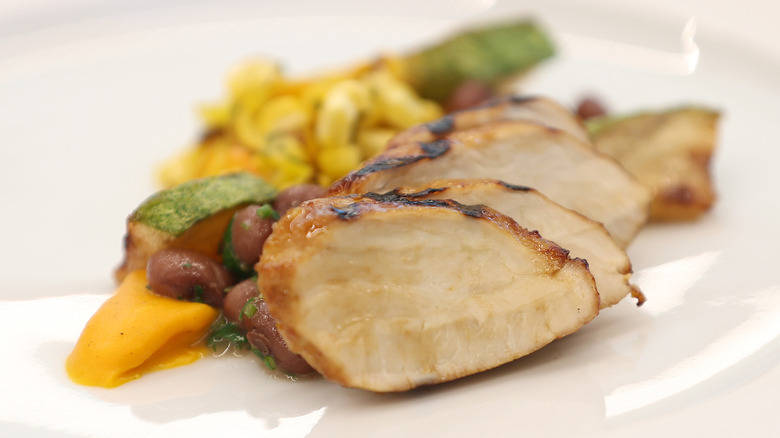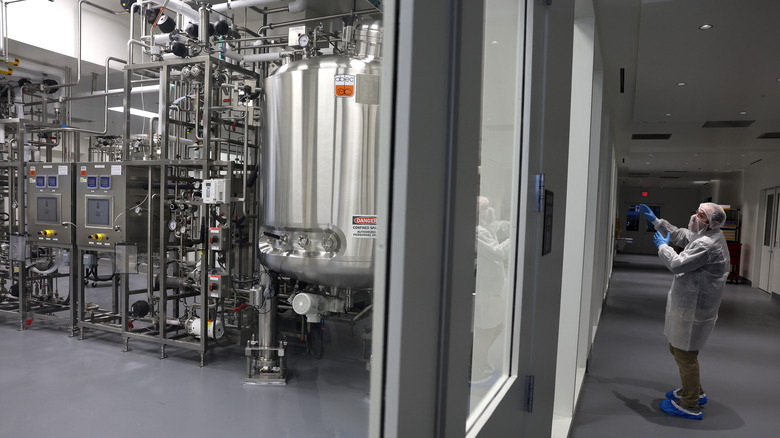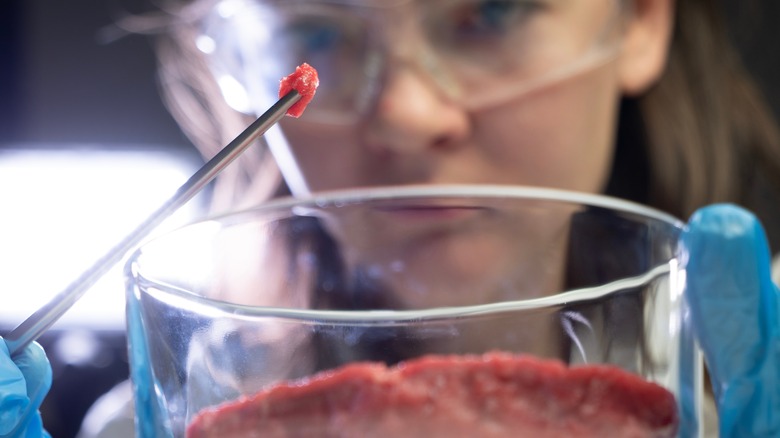How To Identify Lab-Grown Chicken When It Finally Hits Grocery Store Shelves
Cell-cultivated meat sounds like something straight out of science fiction, but last year, it became a reality in the United States. The USDA approved the commercial sale of these foods for two companies that chicken: Good Meat and Upside Foods. This approval means that legally, they can sell their products to the public. However, cell-cultivated meat has yet to become widely available at grocery stores — producing it is expensive and difficult to do on a large scale.
If and when it does hit grocery store shelves, the label approved by the USDA for these products is "cell-cultivated chicken". In the state of Iowa, it is required to include words like "lab-grown," "lab-created," "fake," or "cell-cultivated" on the labels. It will likely be stocked alongside other meat products because it's grown from real animal cells, making it biologically identical to conventional chicken.
It's become possible to taste cell-cultivated meat in the United States over the past few years. After the regulatory approval, Chef José Andrés was the first to serve Good Meat at his Peruvian restaurant, China Chilcano, in Washington, D.C. Elsewhere, Upside Food's cell-cultivated chicken was featured on a tasting menu at Chef Dominique Crenn's San Francisco restaurant, Bar Crenn (she's also the owner of one of the only three Michelin star establishments in the United States). As the process becomes more affordable and scalable, the goal is to make it more widely available to the average consumer.
How is cell-cultivated meat made?
We have mushrooms that taste like chicken, and now chicken that can be harvested and served without having to slaughter the animal. The easiest way to understand cell-cultivated meat is by thinking about brewing beer. The first step is extracting cells from live animals (the animals are not harmed or injured during this process). Afterward, they're placed in large steel bioreactors — like you would see in a beer brewery — along with a growth culture medium.
The cells receive the same ingredients that animals need to live and grow, like vitamins, amino acids, proteins, etc., and continue to multiply. Muscle tissue begins to form, reaching the texture and structure of meat. Often, an edible scaffolding is incorporated with the cells to form more complex and realistic cuts of meat. After about eight to 12 weeks, the lab grown meat is ready to harvest.
This is the standard process for producing cell-cultivated chicken and any other meat or seafood. In fact, there are 174 companies around the world using this process to create cell-cultivated meats and other animal-based products, like skincare treatments or medicine. Any animal cell can be extracted and used in this process — there are companies creating lab-grown sushi-grade bluefin tuna, wagyu beef cuts, pork, hamburgers, shrimp, salmon, and really whatever animal or seafood you can imagine.
Is cell-cultivated meat sold outside of the United States?
The world's first commercial sale of cell-cultivated meat occurred in Singapore back in 2020. As of May 2024, Good Meat 3 is available for customers to purchase and cook at home, found in a store called Huber's Butchery in the South Asian city-state. The product is a blend of cell-cultivated chicken and plant-based proteins that costs $7.20 SGD (about $5.62 USD) for around 4 ounces. Only a handful of other companies have been approved for the commercial sale of such meat outside of Good Meat and Upside Foods. In Singapore, a company called Vow was approved to sell its quail, and the Israel-based Aleph Farms, based in Israel, was given the green-light for its beef.
Another reason we haven't seen cell-cultivated meat in grocery stores is because a few states — and one country, Italy — have already banned their manufacture and sale. Others are considering restrictions, slowing down the approval process. Notably, the states of Florida and Alabama have implemented varying degrees of bans on such meats, citing reasons for protecting farmers and food traditions. For now, there is only one butcher shop where cell-cultivated chicken can be purchased in Singapore. Where you live will depend on how the product is labeled and sold — and it may continue to be unavailable in certain states and countries.


